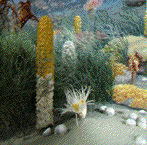The Cambrian Mass Extinction

Fast Facts
-the Cambrian period ranges from 543-510
million years ago
-the most important animal group of the Cambrian
were the trilobites
-four mass extinctions occurred during the
course of the Cambrian
Geological Setting
During the Cambrian period
the world was largely covered by epeiric seas, and existing
organisms were entirely marine. At the beginning of the
period, only small skeletonized sponges and molluscs were
present, but by about the middle of the Cambrian,
diversification of the shelly fauna occurred. The most
important phyla present in Cambrian communities included
trilobites, archaeocyathids, brachiopods, molluscs, and
echinoderms.
Species Affected
At least four major extinctions occurred during the
Cambrian. The first extinction occurred
at the Early Cambrian epoch boundary.
During this event, the oldest group of trilobites, the
olnellids, perished as well as the primary reef-building
organisms, the archaeocyathids. The remaining three extinctions were irregularly distributed around the Late Cambrian epoch boundary, and as a whole, severly affected trilobites, brachiopods, and conodonts.
 Causes of the Cambrian Mass Extinction
Causes of the Cambrian Mass Extinction
 Mass Extinctions of the Phanerozoic Menu
Mass Extinctions of the Phanerozoic Menu
 Main Menu
Main Menu